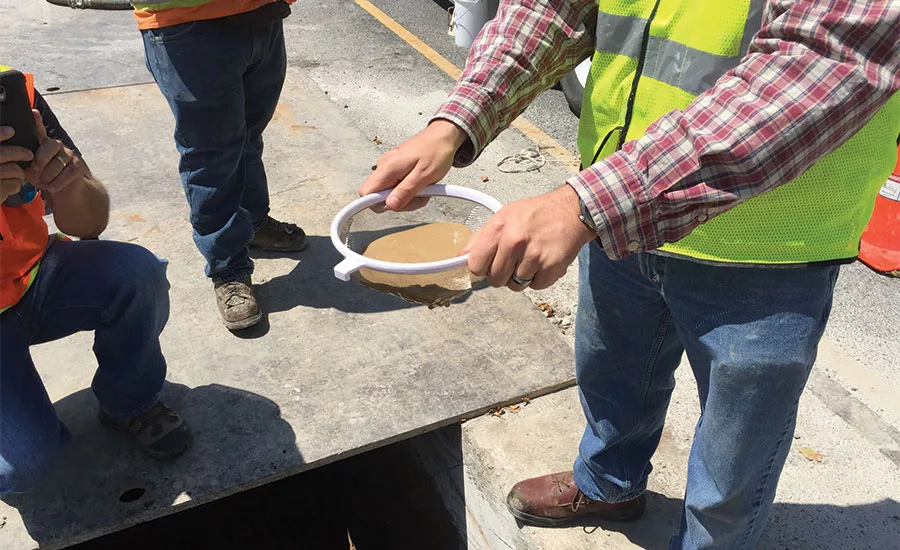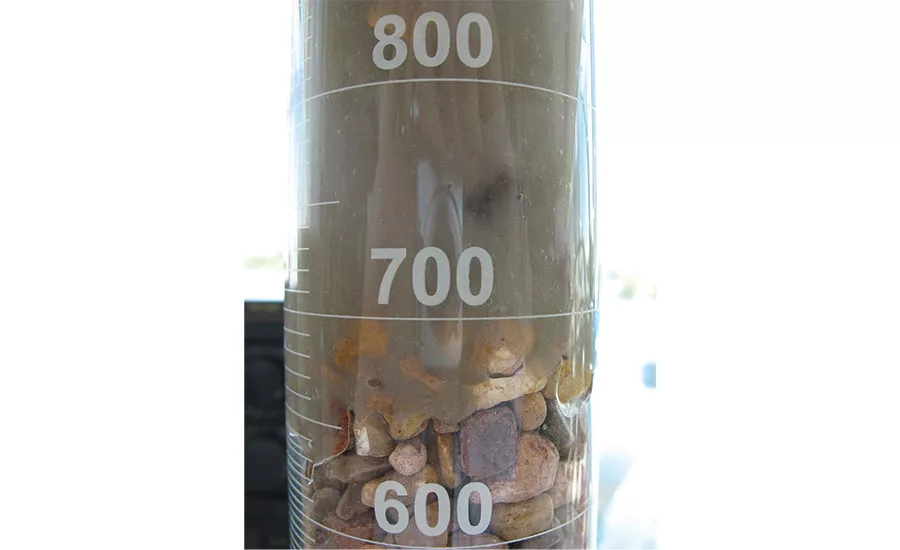The Basics of a Mixed-Metal Fluid System for Drilling Jobs

A good mixed-metal system shows craters and ripples on the surface, as shown in the picture above, where fluid has splashed from the inlet recycling line.
Source: CETCO Drilling Products photos

When poured into a coarse-mesh sieve, mixed-metal fluids should come to rest. The fluid should then easily pour through the sieve when agitated.
Source: CETCO Drilling Products photos

A 2.5-percent solids MMO fluid still sits on top of pea gravel in a graduated cylinder after 5 hours at room temperature. Note the pinkish rock that was picked up and suspended above the 800 mL mark.
Source: CETCO Drilling Products photos
Back in early 2000, when I first started working with mixed-metal hydroxide, very few drillers had ever heard this type of fluid and even fewer had ever seen it used.
While MMH has been used sparingly in the oilfield since about 1992, a whole host of issues prevented its wider acceptance for shallow aqueous jobs. Foremost of these was the fact that a mixed-metal fluid looks rather strange and overly thick. There has been more than one occasion where a well-meaning mud man ruined a beautiful MMH fluid by dosing it with dispersant.
Over the years, we have watched as understanding and acceptance of mixed-metal fluids has grown. Today, all of the major fluids companies offer a mixed-metal additive in their lines. These all work similarly, although some claim benefits (real or imagined) over the competing versions. A lot of the real benefit is found in the quality of technical support one company offers, or in the additives available for the mixed-metal systems they offer.
While the technology has toddled forward over the years, we are still left with another fundamental problem for all mixed-metal systems: They are very hard to test in the field. You can’t use a Marsh funnel because a good MMO fluid will sit in the cone forever without ever filling the cup. The six-speed Fann viscometer is of questionable use (and, certainly, the two-speed version is useless for reasons I will explain next month). So, what do we have left? Lots of qualitative evaluation and the tricks I discuss here and in next month’s column.
First, for the uninitiated, I will briefly explain what a mixed-metal-type fluid is and how it works. A mixed-metal fluid uses a combination of colloidal clay (bentonite or attapulgite) along with a weakly cationic, microscopic crystalline additive (the mixed-metal part). Mixed-metal fluids are amazingly shear thinning and can suspend rocks as large as golf balls while remaining pumpable and thin under shear. They are probably the single best fluid one can run in gravel or under rivers. Mixed-metal fluids are intolerant of anionic additives and require long mixing periods to get the best performance. Mixing of up to an hour per batch is not uncommon and the ideal base clays are all untreated API Section 10 compliant.
The mixed-metal additives generally fall into one of three commercial-grade classes:
- MMH (mixed-metal hydroxide): The oldest form. It’s the most expensive and finicky, as well. Primarily composed of magnesium, aluminum and associated hydroxides. It is extremely intolerant of anionic additives, moisture and air exposure, and has a very short shelf life. Pure, fresh MMH can do amazing things, but I have not seen it available in its pure form in years.
- MMO (mixed-metal oxide): Similar to MMH, but cheaper to produce. It is more commonly available than MMH, and often less difficult to use. Can be made from MMH with heat. Most types are cut with other additives that help prolong shelf life or help deal with added anionics.
- MMS (mixed-metal silicate): A different crystal structure and elemental make-up. This material was created to get around patents on the other two materials. It is often sold as a blend and performs similarly to the various MMO types.
No matter what someone tells you, all mixed-metal fluids work best with untreated bentonite that has no polymer additions (API 13A Section 10 or similar). While it is possible to make a good mixed-metal fluid using treated clays, it will generally require more mixed-metal additive, more clay, longer mixing times and, therefore, higher cost than using untreated.
Finally, a mixed-metal system can be pumped at very low pressures (half or lower) and at slower pumping rates, since you don’t have to worry about turbulent flow to carry cuttings.
The Great Truth
Before we go any further, let’s discuss The Great Truth of Mixed-Metal Systems:
There are true mixed-metal systems and there are things that pretend to be mixed-metal systems because they contain a mixed-metal ingredient. Not everything that contains a mixed-metal material displays true mixed-metal rheology.
It is very easy to ruin a mixed-metal dosed mud and thereby convert it into something that has few or even none of the true benefits we hope to achieve with this technology. The best mixed-metal systems can suspend rocks the size of golf balls and yet look watery under shear. If your fluid cannot do this, you have something less than an ideal mixed-metal rheology. Mixed-metal-type fluids have gotten a bad name in some circles due to incomplete understanding, aggressive sales practices (i.e. false advertising) and impatience on the drilling end. These systems, however, can be cheap and easy to run if you design them well.
Here is the recipe for an ideal mix:
- Fresh water
- 0.5 pound/barrel soda ash (2-minute mix)
- 8 to 10 pounds/barrel API 13A Section 10-compliant bentonite (30-minute high-shear mix)
- 1 pound/barrel mixed-metal additive (20-minute high-shear mix)
Then, just maintain the pH at or above 10.0 with soda ash or caustic soda. That’s it.
Now that you have your next fluid for river crossing or gravel drilling, how do you evaluate it? Let’s start looking at some methods.
Simple Appearance
In the mixing tank, a good-quality MMO or MMS fluid will have a pock-marked surface, with craters and ripples. It will flow from a recirculating line like water, but where the fluid splashes, it will freeze and show every drop and splatter. If the surface in your tank is flat or gently sloshing in waves, then you do not have ideal mixed-metal rheology. There should not be significant amounts of water on the surface. Syneresis or water bleed mean that you have an over-flocculated system that is not yielded out and more mixing time is needed. If you do not see craters after 20 minutes of mixing, add an extra half-a-percent more bentonite and few pounds more mixed-metal additive and shear for an additional 20 minutes.
Sieve Test
One simple test is to pour your fluid gently into a mesh sieve as shown in the picture on the previous page. After some initial flow-through, the fluid should come to rest, partially filling the sieve. When you shake the sieve, this fluid will flow through again like rain, leaving behind any suspended cuttings. Some of these cuttings can be as large as an inch across. Mixed-metal-type fluids are great for recycling systems.
Filtrate Loss
We have been taught that low filtrate loss is desirable in all drilling conditions — especially for sand, gravel and cobble geology. A mixed-metal system does not need good filtrate loss as tested by traditional API procedures. This is heresy to many of you, but real-world experience has proved this out. Anything you add to your mixed-metal system, no matter how low-charge it may be, can decrease the suspension of your system, and that suspension is the primary reason to use mixed-metal fluids.
Very few things in this world are truly non-ionic. If we are lucky, we might be able to maintain 80 percent of our starting suspension ability after we add some “non-ionic” starch, but even these additives have some anionic character that interferes with the magical associations between our mixed-metal additives and our clay. I have tested supposedly MMO-safe filtrate loss additives and, in some cases, found that my suspension had dropped to levels no better than running a standard bentonite mud. What a waste of money and potential.
Now, that is not to say that there are no additives you can use to improve filtrate loss. Many mineral-based or plastic lost-circulation-materials can work. The swelling types of LCM and wood fibers are not good choices (both are surprisingly anionic). PAC is best avoided.
With that said, I also want to argue that filtrate loss is not all that important for mixed-metal additive fluids. Loss with good mixed-metal fluids is surprising low. Firstly, we use these fluids at very low pump pressures with relatively low pumping rates. Secondly, these fluids will flow out into a formation for only a few inches or so and then completely stop.
This brings me to another good test to judge the quality of your mixed-metal-additive fluid. Pour your mud into a glass-walled jar filled with a deep bed of pea gravel and put the jar somewhere quiet for a half-hour or so. A good MMO fluid will sit on top and not sink into the pea gravel beyond an inch or two. A poor-quality MMO fluid will eventually flow to the bottom like a traditional drilling mud. Additions of CMC or PAC will not help your fluid stay atop the gravel, although those materials can certainly slow it down. Only a good-quality mixed-metal fluid will completely stop just beyond the top of the rocks — and may even suspend a few.
This introduction scratches the surface of the topic of mixed-metal fluids, including what they are and how to put them to work on your drilling jobs. Next month, we’ll take a closer look at methods for evaluating them, including using a shearometer and — my favorite — a ball harp.
Looking for a reprint of this article?
From high-res PDFs to custom plaques, order your copy today!



